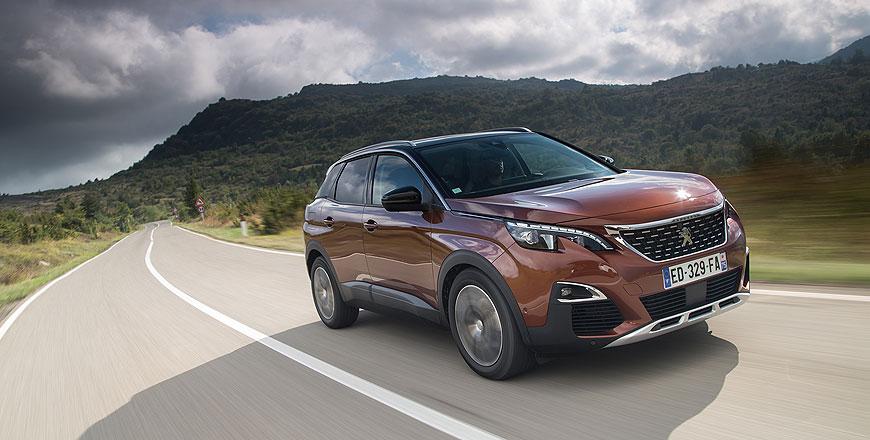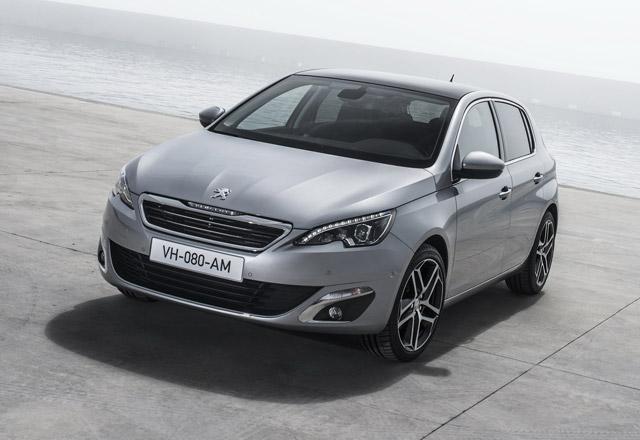You are here
Prodigious three-pot Pug
By Ghaith Madadha - Oct 07,2014 - Last updated at Oct 07,2014

The latest addition to Peugeot’s award-winning and recently launched second generation 308 family hatchback and estate range, the 1.2-litre PureTech 130 is the most powerful of three petrol three-cylinder engines designed to reduce fuel consumption and emissions without sacrificing performance.
Characterised by its abundant mid-range torque for such a tiny power plant, the PureTech 130 is especially well-suited to the elegant SW estate version of the 308, and its generous cargo capacity. Driven in manual gearbox guise at a recent launch event in Mallorca, Spain, the 308 SW 1.2 PureTech 130 is a refined, stylish, practical, reassuring, agile, brisk and sensible contemporary family car.
Elegant estate
Launched earlier this year at the Geneva motor show, the 308 SW is the more practical, stable and arguably better looking estate sister to the 308 hatchback introduced late last year. Given their shared rear tailgate style, the 308 SW is essentially a stretched version of the 308 hatchback, with its additional 332mm length divided between a 110mm longer wheelbase providing extra rear seat space and a 222mm longer rear overhang for a more accommodating boot.
The longer wheelbase also allows a wider door for improved rear access and better road grip, while profile aesthetic benefits from the use of three similarly sized windows.
Classy and compact, the 308 SW’s elongated profile is tightly penned but has a more elegantly flowing design to its rook and flanks. With a refined front fascia featuring a chrome-ringed two-slat grille, the 308 SW’s lion emblem sits in a concave groove on its bonnet, while its moody headlights feature a slight lower indentation.
An LED strip reflects the trapezoidal grille’s angle and tapers off to a side crease that runs through the door handles and to a metallic strip carved through the wraparound rear lights. A gently descending roofline and large 225/45R17 footwear lend a sporty and eager demeanour and road stance.
Tri-cylinder turbo
Offered in naturally aspirated 81BHP and 109BHP and 129BHP turbocharged versions, Peugeot’s new 1.2 litre three cylinder PureTech engine is a more efficient engine than the previous generation 308’s 1.6 litre naturally aspirated four cylinder engine. More powerful and torqueier in turbo versions as well, the more powerful version driven develops 129BHP at 5,500rpm and
170lb/ft torque throughout 1,750-3,500rpm.
Prodigious for its small displacement, the PureTech 130’s torque output is just 7lb/ft shy of Peugeot’s larger 1.6 litre turbocharged THP 165, and allows for effortless load lugging, flexible mid-range operation and relaxed motorway cruising, while returning frugal 5L/100km fuel efficiency and 115g/km carbon dioxide emissions with the beefier 225/45R17 tyres as tested.
With little low-end turbo lag, a generous mid-range and eager to be revved character, the 308 SW three-pot turbo engine carries its 1,190kg frame from standstill to 100km/h in 10.6-seconds — as tested — and onto 199km/h, while mid-range flexibility allows for 11.5 second 80-120km/h acceleration in fifth gear.
As smooth and refined as three-cylinder engines come, the 1.2 PureTech feature a balancer shaft to reduce the three-cylinder configuration’s inherent vibrations. Welling up from around 2,000rpm, the 308 PureTech 130 is in its stride by 2,500rpm, brisk by 3,000rpm and with a distinctive but muted three-cylinder growl, is willing to be thrashed right to its redline.
Supple and smooth
Mated to a satisfyingly mechanical feeling six speed gearbox clicking precisely into gear and with light but intuitive clutch, the prodigious three-pot Pug is fun and brisk in real-world driving. With a smaller and lighter engine over its driven front wheels, the 308 SW PureTech is eager, light and crisp into corners, with less understeer and less pronounced weight transfer.
Tidy into corners, the 308’s electric-assisted rack and pinion steering delivers decent road feel and feedback. Body lean isn’t particularly pronounced, but with its sticky tyres, reassuring chassis characteristics and longer wheelbase, the 308 SW grips harder and is more stable through corners than its hatchback sister.
A smooth and refined ride, the 308 SW is well insulated inside and even with the second largest alloy wheel option, is supple and forgiving over broken roads, cracks and bumps. More stable and grippier than its hatchback sister, the 308 SW is reassuring at speed, whether straight or sweeping corners, and settles with taut composure on rebound from undulations.
Being a family hatchback derived estate with a light engine, the 308 SW is also surprisingly agile and nippy for a vehicle with such a high cargo carrying capacity. Some 140kg lighter than its predecessor, the 308 SW is poised, eager and tidy through countryside switchbacks and is manoeuvrable in town.
Cavernous cabin
The most accommodating in its segment and more generous than many larger cars, the 308 SW’s cavernous load bay takes a minimum 660-litre volume, which with flat 60:40 split-folding rear seats down, expands to 1,775 litres when loaded to the roof.
Practical and spacious, the 308 SW’s tailgate is wide and its load floor low for easy loading, while a centre ski hatch accommodates long objects without folding the rear seats. The 308 SW features under-floor storage, space saver spare tyre, load floor rails with movable latching points to secure cargo and well-sized main console storage and glove boxes — however, other console storage space is limited.
Classier than many rivals, the 308’s uncluttered cabin has a stylishly minimalist ambiance, with most functions controlled through its intuitive infotainment touchscreen. With tasteful and good quality fit, finish textures and colours, the 308 feels a cut above expectation.
Seats are supportive, adjustable and comfortable, and visibility is good. One peers at the instrument panel over a chic small steering wheel for better road view, but for larger drivers, a conventional steering position might be preferable when driving through brisk switchbacks. Rear seat space is also decent, but rear headspace would be better still for tall occupants without the optional and airy feeling panoramic sunroof.
Driven in second to top Allure spec, the 308 SW featured electric folding mirrors, reversing camera and front parking sensors, LED headlamps, front foglights and optional panoramic sunroof and keyless entry.
Other features standard to the Allure include Bluetooth and USB connectivity, rear arm rest, all-round three-point seatbelts, rear Isofix childseat latches, 9.7-inch (24.64cm) touchscreen, dual zone climate control, lumbar support, satnav, leather steering and gear knob, stability and traction control and electric handbrake.
Available optional equipment includes leather massage seats, a city park system with blind spot monitoring, driver assistance pack with dynamic cruise control and emergency collision warning and braking systems, among other options.
TECHNICAL SPECIFICATIONS
Engine: 1.2 litre, turbocharged, transverse 3 cylinders
Bore x stroke: 75 x 90.5mm
Valve-train: 12 valve, DOHC, direct injection
Gearbox: 6 speed manual, front-wheel drive
Power, BHP (PS) [kW]: 129 (130) [96] @ 5500rpm
Specific power: 106.7BHP/litre
Power-to-weight: 107.5BHP/tonne
Torque, lb/ft (Nm): 170 (230) @ 1,750-3,500rpm
Specific torque: 191.8Nm/litre
Torque-to-weight: 193.2Nm/tonne
0-100km/h: 10.6 seconds
80-120kmh, 5th/6th gear: 11.5-/14-seconds
Maximum speed: 199km/h
Fuel consumption, urban/extra-urban/combined: 6.2-/4.3-/5 litres/100km
CO2 emissions, combined: 115g/km
Fuel tank: 53 litres
Length: 4,585mm
Width: 1,804mm
Height: 1,471mm
Wheelbase: 2,730mm
Track, F/R: 1,559/1,553mm
Overhang, F/R: 863/992mm
Boot capacity, min/max: 660/1,775 litres
Kerb weight: 1,190kg
Steering: Electric assisted rack and pinion
Suspension, F/R: MacPherson struts/torsion bar
Brakes, F/R: Ventilated discs/discs
Tyres, F/R: 225/45R17
Related Articles
Well-received for its driving dynamic and design when launched, the new second generation Peugeot 308 debuted it’s new 1.2 PureTech engine family last year. Smooth and efficient, the PureTech engine is a petrol-powered counterpoint to more complex and costly and less hard-wearing or refined turbo-diesel and hybrid efficiency models.
Launched globally late last year as a 2017 model and soon due in Jordanian showrooms, the new second generation Peugeot 3008 compact crossov
Peugeot’s answer to the Volkswagen Golf, Ford Focus and other C-segment family hatchbacks, the 308 is a handsomely elegant offering with an



















